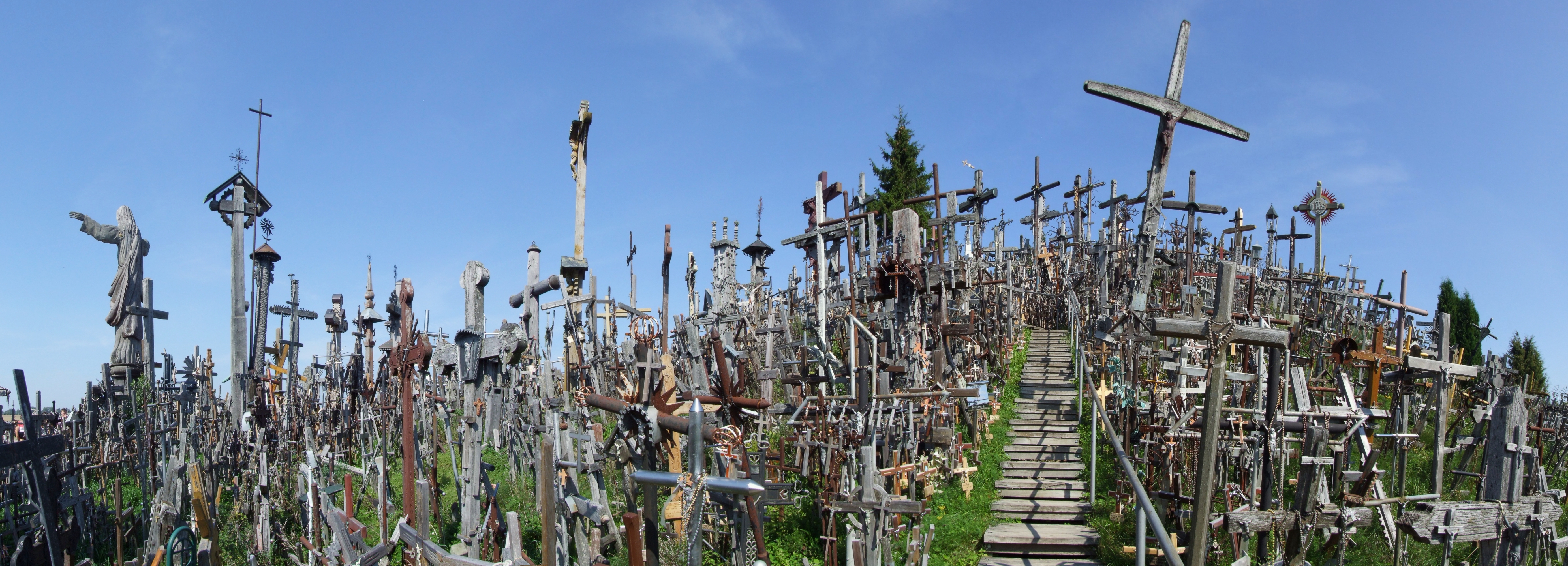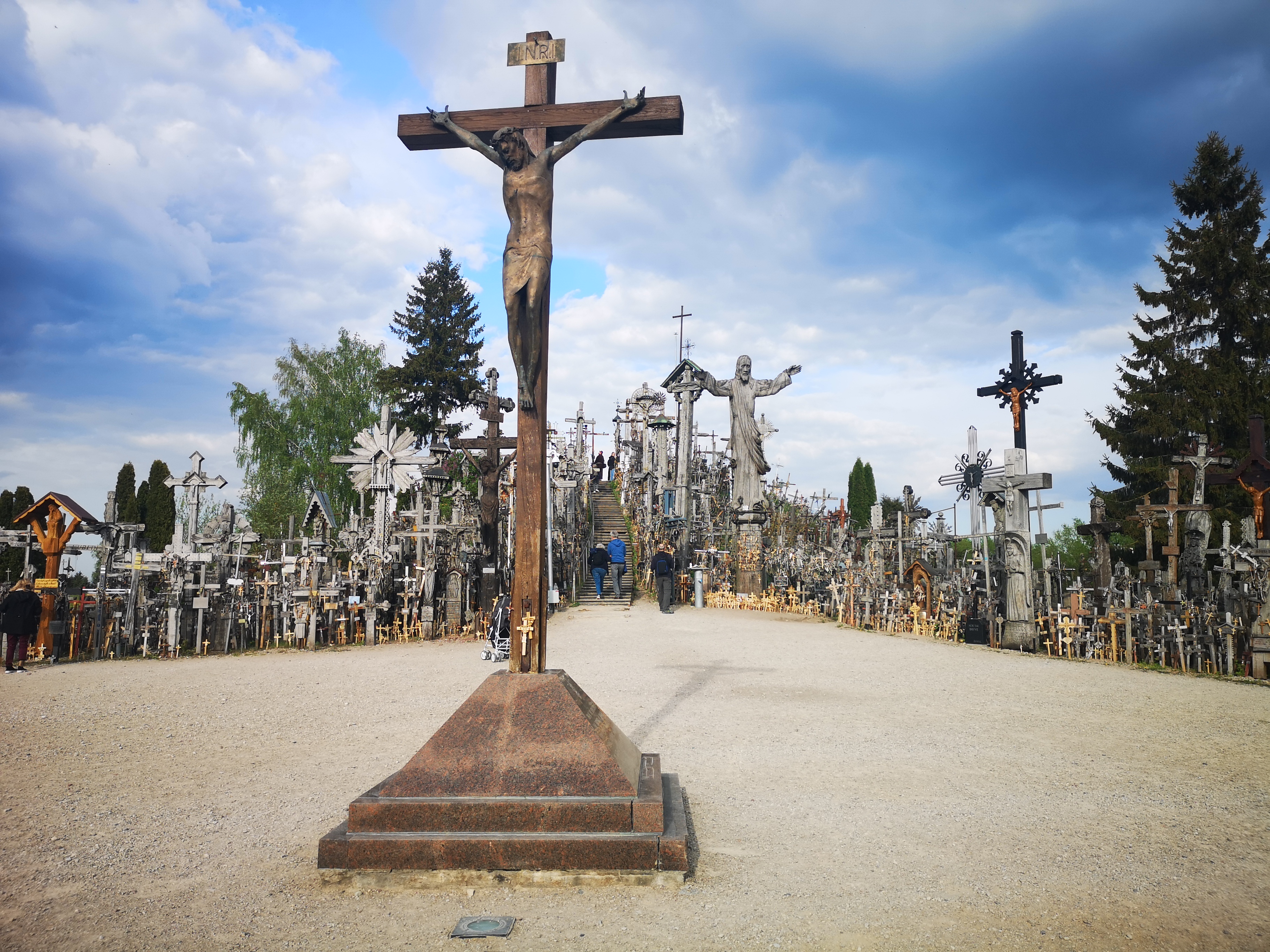Hill of Crosses on:
[Wikipedia]
[Google]
[Amazon]

 Hill of Crosses ( Lithuanian: ) is a site of
Hill of Crosses ( Lithuanian: ) is a site of 



File:Kryziu kalno koplycia nakti 20150818.jpg, Chapel
File:Johannes Paulus II 1993.jpg,
HillofCrosses.org
KryziuKalnas.lt
Hill of Crosses Lithuania
HillofCrosses.com
{{Authority control Catholic pilgrimage sites Landmarks in Lithuania Religious buildings and structures in Lithuania Roman Catholic shrines in Lithuania Votive offering Buildings and structures in Šiauliai County Tourist attractions in Šiauliai County
pilgrimage
A pilgrimage is a journey, often into an unknown or foreign place, where a person goes in search of new or expanded meaning about their self, others, nature, or a higher good, through the experience. It can lead to a personal transformation, aft ...
about 12 km north of the city of Šiauliai
Šiauliai (; bat-smg, Šiaulē; german: Schaulen, ) is the fourth largest city in Lithuania, with a population of 107,086. From 1994 to 2010 it was the capital of Šiauliai County.
Names
Šiauliai is referred to by various names in different la ...
, in northern Lithuania. The precise origin of the practice of leaving crosses on the hill is uncertain, but it is believed that the first crosses were placed on the former Jurgaičiai or Domantai hill fort
A hillfort is a type of earthwork used as a fortified refuge or defended settlement, located to exploit a rise in elevation for defensive advantage. They are typically European and of the Bronze Age or Iron Age. Some were used in the post-Roma ...
after the 1831 Uprising
The November Uprising (1830–31), also known as the Polish–Russian War 1830–31 or the Cadet Revolution,
was an armed rebellion in the heartland of partitioned Poland against the Russian Empire. The uprising began on 29 November 1830 in W ...
. Over the generations, not only cross
A cross is a geometrical figure consisting of two intersecting lines or bars, usually perpendicular to each other. The lines usually run vertically and horizontally. A cross of oblique lines, in the shape of the Latin letter X, is termed a sa ...
es and crucifix
A crucifix (from Latin ''cruci fixus'' meaning "(one) fixed to a cross") is a cross with an image of Jesus on it, as distinct from a bare cross. The representation of Jesus himself on the cross is referred to in English as the ''corpus'' (Lati ...
es, but statues of the Virgin Mary
Mary; arc, ܡܪܝܡ, translit=Mariam; ar, مريم, translit=Maryam; grc, Μαρία, translit=María; la, Maria; cop, Ⲙⲁⲣⲓⲁ, translit=Maria was a first-century Jewish woman of Nazareth, the wife of Joseph and the mother of ...
, carvings of Lithuanian patriots and thousands of tiny effigies
An effigy is an often life-size sculptural representation of a specific person, or a prototypical figure. The term is mostly used for the makeshift dummies used for symbolic punishment in political protests and for the figures burned in certai ...
and rosaries
The Rosary (; la, , in the sense of "crown of roses" or "garland of roses"), also known as the Dominican Rosary, or simply the Rosary, refers to a set of prayers used primarily in the Catholic Church, and to the physical string of knots or b ...
have been brought here by Catholic
The Catholic Church, also known as the Roman Catholic Church, is the largest Christian church, with 1.3 billion baptized Catholics worldwide . It is among the world's oldest and largest international institutions, and has played a ...
pilgrim
A pilgrim (from the Latin ''peregrinus'') is a traveler (literally one who has come from afar) who is on a journey to a holy place. Typically, this is a physical journey (often on foot) to some place of special significance to the adherent of ...
s. The exact number of crosses is unknown, but estimates put it at about 55,000 in 1990 and 100,000 in 2006. It is a major site of Catholic pilgrimage in Lithuania.

History
Over the generations, the place has come to signify the peaceful endurance of Lithuanian people despite the threats they faced throughout history. After the 3rd partition of the Polish–Lithuanian Commonwealth in 1795, Lithuania became part of theRussian Empire
The Russian Empire was an empire and the final period of the Russian monarchy from 1721 to 1917, ruling across large parts of Eurasia. It succeeded the Tsardom of Russia following the Treaty of Nystad, which ended the Great Northern War. ...
. Poles and Lithuanians unsuccessfully rebelled against Russian authorities in 1831
Events
January–March
* January 1 – William Lloyd Garrison begins publishing '' The Liberator'', an anti- slavery newspaper, in Boston, Massachusetts.
* January 10 – Japanese department store, Takashimaya in Ky ...
and 1863
Events
January–March
* January 1 – Abraham Lincoln signs the Emancipation Proclamation during the third year of the American Civil War, making the abolition of slavery in the Confederate states an official war goal. It proclaim ...
. These two uprisings are connected with the beginnings of the hill: as families could not locate bodies of perished rebels, they started putting up symbolic crosses at the site of a former hill fort.
When the old political structure of Eastern Europe
Eastern Europe is a subregion of the European continent. As a largely ambiguous term, it has a wide range of geopolitical, geographical, ethnic, cultural, and socio-economic connotations. The vast majority of the region is covered by Russia, whic ...
fell apart in 1918, Lithuania once again declared its independence. Throughout this time, the Hill of Crosses was used as a place for Lithuanians to pray for peace, for their country, and for the loved ones they had lost during the Wars of Independence
This is a list of wars of independence (also called liberation wars
Wars of national liberation or national liberation revolutions are conflicts fought by nations to gain independence. The term is used in conjunction with wars against for ...
.
The site took on a special significance during the years 1944–1990, when Lithuania was occupied by the Soviet Union
The Soviet Union,. officially the Union of Soviet Socialist Republics. (USSR),. was a List of former transcontinental countries#Since 1700, transcontinental country that spanned much of Eurasia from 1922 to 1991. A flagship communist state, ...
. Continuing to travel to the hill and leave their tributes, Lithuanians used it to demonstrate their allegiance to their original identity, religion and heritage. It was a venue of peaceful resistance, although the Soviets worked hard to remove new crosses, and bulldozed the site at least three times (including attempts in 1963 and 1973). There were even rumors that the authorities planned to build a dam on the nearby Kulvė River, a tributary to Mūša
Mūša ( lv, Mūsa; German: Muhsse) is a river in Northern Lithuania and Southern Latvia (Zemgale region). At its confluence with the river Nemunėlis ( lv, Mēmele) in Latvia, near city Bauska, the river Lielupė is formed. The river is 164 ...
, so that the hill would end up underwater.
On September 7, 1993, Pope John Paul II
Pope John Paul II ( la, Ioannes Paulus II; it, Giovanni Paolo II; pl, Jan Paweł II; born Karol Józef Wojtyła ; 18 May 19202 April 2005) was the head of the Catholic Church and sovereign of the Vatican City State from 1978 until his ...
visited the Hill of Crosses, declaring it a place for hope, peace, love and sacrifice. In 2000 a Franciscan
, image = FrancescoCoA PioM.svg
, image_size = 200px
, caption = A cross, Christ's arm and Saint Francis's arm, a universal symbol of the Franciscans
, abbreviation = OFM
, predecessor =
, ...
hermitage was opened nearby. The interior decoration draws links with La Verna
La Verna ( la, Alverna is a locality on Mount Penna ( it, Monte Penna), an isolated mountain of situated in the centre of the Tuscan Apennines, rising above the valley of the Casentino, central Italy. The place is known especially for its ass ...
, the mountain where St. Francis is said to have received his stigmata
Stigmata ( grc, στίγματα, plural of , 'mark, spot, brand'), in Roman Catholicism, are bodily wounds, scars and pain which appear in locations corresponding to the crucifixion wounds of Jesus Christ: the hands, wrists, and feet.
Sti ...
. In May 2013, Šiauliai District Municipality
Šiauliai District Municipality is one of 60 municipalities in Lithuania.
References
Municipalities of Šiauliai County
Municipalities of Lithuania
{{lithuania-geo-stub ...
adopted rules regarding the placement of crosses. People are allowed to erect wooden crosses less than in height with no permits.
In December 2019, a tourist from China removed and tossed away a cross believed to be set up by the Hong Kong pro-democracy camp. She later condemned the protesters in a Twitter post and in an Instagram video saying, "We have done a good thing today. Our motherland is great." Lithuanian Foreign Minister Linas Linkevičius Linas is a Lithuanian male given name. It is the Lithuanian form of the name Linus, which derives from the Greek for "flax
Flax, also known as common flax or linseed, is a flowering plant, ''Linum usitatissimum'', in the family Linaceae. It is ...
condemned the woman's action in a tweet that called it a "shameful, disgraceful act of vandalism" and said such behavior "can't and won't be tolerated".



Pope John Paul II
Pope John Paul II ( la, Ioannes Paulus II; it, Giovanni Paolo II; pl, Jan Paweł II; born Karol Józef Wojtyła ; 18 May 19202 April 2005) was the head of the Catholic Church and sovereign of the Vatican City State from 1978 until his ...
File:Kryziu kalnas nakti 2014-12-25.jpg, Hill of Crosses at night
File:Colina de las Cruces, Lituania, 2012-08-09, DD 02.JPG
File:Colina de las Cruces, Lituania, 2012-08-09, DD 06.JPG
File:Colina de las Cruces, Lituania, 2012-08-09, DD 13.JPG
File:Colina de las Cruces, Lituania, 2012-08-09, DD 15.JPG
File:Colina de las Cruces, Lituania, 2012-08-09, DD 19.JPG
File:Colina de las cruces 2016.jpg
File:Hill of crosses in Lithuania.jpg
See also
*Lithuanian cross crafting
Lithuanian cross crafting ( lt, Lietuvos kryždirbystė) is a traditional Lithuanian art of crafting crosses. The making of altars and crosses is an important part of Lithuanian culture. Lithuanian traditional crosses are part of the people's Ro ...
*Three Crosses
Three Crosses ( lt, Trys kryžiai, pl, Góra Trzykrzyska) is a prominent monument in Vilnius, Lithuania, on the Hill of Three Crosses, originally known as the Bald Hill ( lt, Plikasis kalnas), in Kalnai Park. According to a legend, which find ...
– prominent monument in Vilnius, capital of Lithuania
*Žemaičių Kalvarija
Žemaičių Kalvarija ( Samogitian: ''Žemaitiu Kalvarėjė'', pl, Kalwaria Żmudzka, en, Samogitian Calvary) is a small town in Plungė district municipality, Lithuania. It is known as a major site for Catholic pilgrimage.
Every July the tow ...
– pilgrimage site in Samogitia
Samogitia or Žemaitija ( Samogitian: ''Žemaitėjė''; see below for alternative and historical names) is one of the five cultural regions of Lithuania and formerly one of the two core administrative divisions of the Grand Duchy of Lithuania ...
, Lithuania
* Khatchkars – Armenian monumental crosses.
* ''''
References
External links
HillofCrosses.org
KryziuKalnas.lt
Hill of Crosses Lithuania
HillofCrosses.com
{{Authority control Catholic pilgrimage sites Landmarks in Lithuania Religious buildings and structures in Lithuania Roman Catholic shrines in Lithuania Votive offering Buildings and structures in Šiauliai County Tourist attractions in Šiauliai County